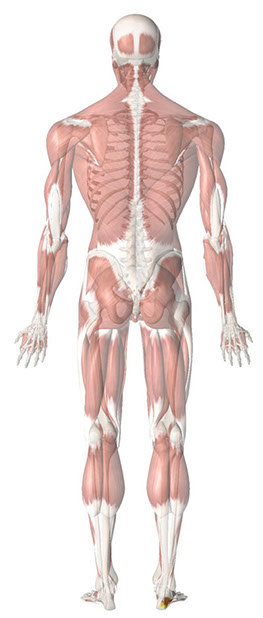Foot & Ankle
Achilles Tendons
Are the Achilles’ tendons vertically straight and the heels not exhibiting excessive pronation or supination?
With a pronated foot (pes planus), the tendo calcaneus (Achilles’ tendon) will present with a C-shaped curvature (concave laterally); in pes cavus, the curvature will be concave medially.
Lower Extremity
Calf Shape
Are the calves shaped like an inverted bottle?
If increased bulk is identified in the inner, lower third of the calf suggests soleus hypertrophy, possibly caused by excessive running and/or high heel usage, which ‘creates a cylindrical shape, which contrasts with the normal inverted bottle shape’ and which may predispose to back pain and/or ankle/foot dysfunction.
Knee Level
When one crease is higher than the other, this indicates structural differences in tibial length.
Lumbo-Pelvic Hip Complex
Coccyx and Sacrum Kyphotic Curvature
Does the coccyx continue the sacrum’s kyphotic curvature and align vertically with the rest of the spine?
Iliac Crest Level
PSIS Level
(A light circular motion of the finger tips while palpating over these protuberances will assist in locating them. The practitioner’s thumbs should be placed immediately inferior to these protuberances, on their inferior slopes, to assist in determining if they are level when the practitioner’s eyes are at the same level as the thumbs.)
Gluteal Folds
Are the gluteal folds (lower margins of the buttocks) of the two sides level and of approximately the same ‘depth’?
With certain pelvic distortions, an anterior rotation of one innominate will ‘lift’ the gluteal tissue, thereby reducing the depth of the fold and making it less of a crease; a posterior rotation of an innominate will make the fold more apparent. Since pelvic distortion often presents with one innominate rotated anteriorly and the other posteriorly, the appearance of the two gluteal folds may be substantially different.
Thoracolumbar Musculature
Suggests overactivity in gait and probable inhibition of gluteus maximus.
Lumbar and Thoracic Spine
Spine alignment
Does palpation of the spinous processes reveal that they align vertically for the entire length of the spine?
If a C-shape or S-shape scoliotic curvature is found then the “forward bend test” described latter should be performed to determine of the deformity is structural or functional.
Shoulder Complex
Are the acromioclavicular joints level with one another?
Scapular Positioning
Are the inferior angles of the scapulae level with each other?
An elevated scapula could be a result of hypertonic trapezius or levator scapula and weak lower trapezius or of hypertonic rotator cuff muscles which may influence scapular positioning. These dysfunctional states could relate to trigger point activity and/or patterns of overuse (see upper crossed syndrome).
Are the medial margins (vertebral borders) of the scapulae parallel to the spinous processes? Is there winging of the scapulae?
If so, lower fixator weakness/inhibition is likely, suggesting overactivity of upper fixators. See upper crossed syndrome below under
Adducted scapula could be a result of hypertonic rhomboids or habitual patterns of use such as the ‘military stance’.
Weak serratus anterior (sometimes resulting from nerve damage of long thoracic nerve) will allow the medial margins to lift away from torso. Some degree of scapular prominence is normal in children.
Trapezius Development
Is there excessive muscular development (hypertrophy) of one lower trapezius due to excessive upper extremity weight bearing on contralateral side (i.e. carrying travel bags, heavy brief case or sample bags)?
Suggests overactivity and probable inhibition/lengthening.
Head & Cervical Spine
Vertical alignment of cervical spine (C2-C5)
Does palpation of the spinous processes reveal that they align vertically from C2 through L5 as well as with the sacral tubercles?
When a noticeable C-shape or S-shape scoliotic curvature is visible or is evident with the ‘red reflex’
This could indicate structural or functional leg length differences, pelvic distortions (often caused by muscular imbalances of adductors, lateral hip muscles, lower back or abdominal muscles), fallen arch, structural abnormality of the spine, muscular imbalances of paraspinal muscles and possible involvement of a primary cranial distortion.
Cervical curvature
Head Tilt
Head Rotation
Earlobe Level
Acromioclavicular joints level
